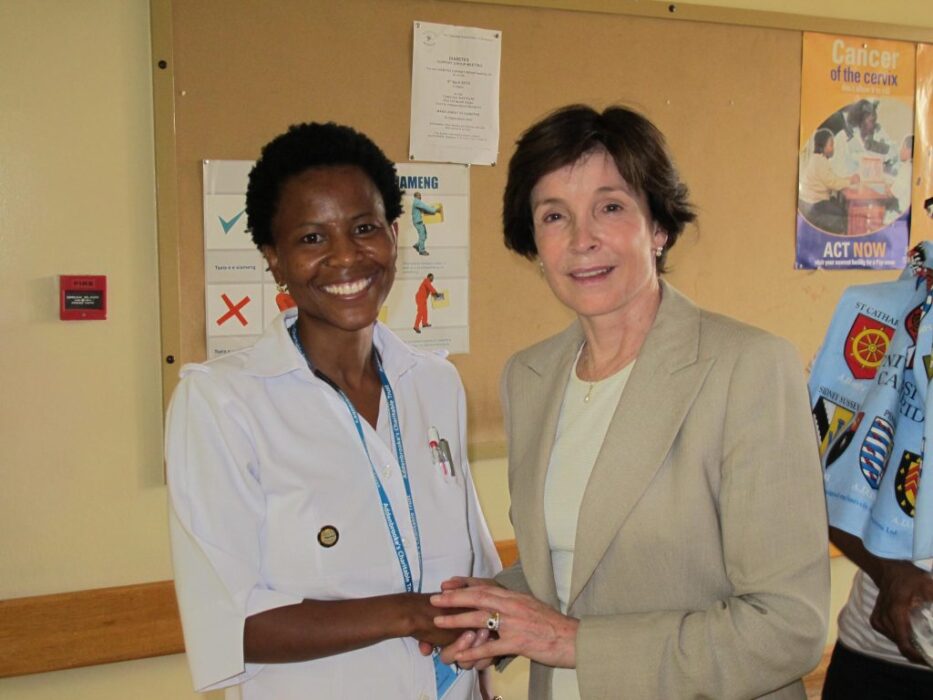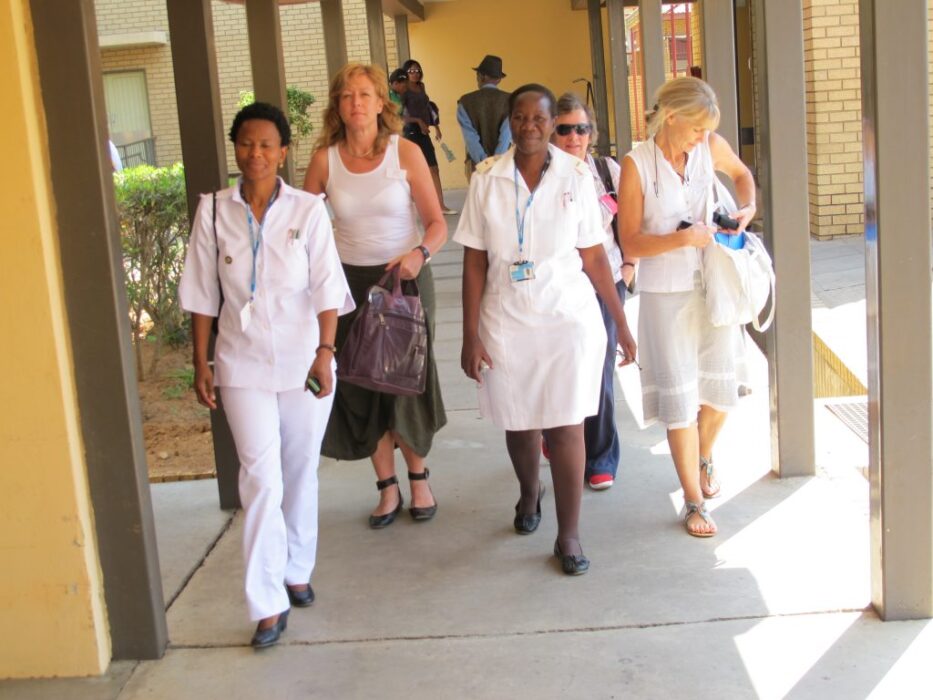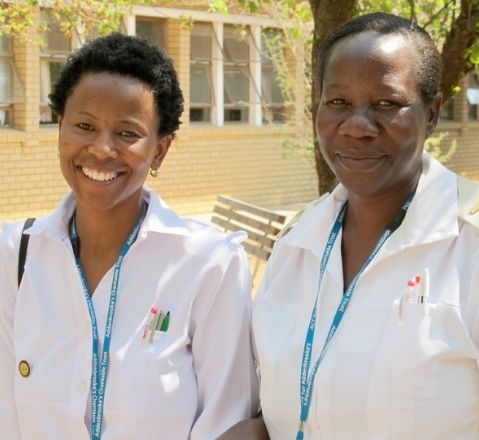We met online with Pearl Katlego Mbulawa. Pearl is as an ophthalmic nurse, specialising in diabetic retinopathy at Princess Marina Hospital (PMH) in Gaborone, Botswana. Pearl trained to be a nurse in IHS Lobatse, before completing her specialised training in ophthalmic nursing in Malawi in 2001.
Pearl has had long standing links with Cambridge dating back to 2006. Working with Dr Malcolm Kerr-Muir, they established diabetic retinopathy services in Botswana. Pearl has championed the development of eye health ever since.
In this story, Pearl shares her journey and experiences of global eye health.
“I started working in ’97. I used to see a nurse bringing in patients with cataracts and unable to walk unaided. After their operation, the following day you would see them walking by themselves and they would be so happy and would be ululating. And I asked this nurse , ‘what is this miracle, what is going on’. And that’s when I asked her, ‘what is it here that you are doing?’ And she told me that she is the eye nurse, and that she would go out on outreaches looking for the patients who have got cataracts and bring them in for surgery. And I just got fascinated, and I said ‘I think this is what I want to do’. In a nutshell, I just wanted to restore sight.”
What does eye health look like in Botswana?
Because I am working in a diabetic centre, we see only diabetic patients. I see diabetic patients every single day, but the main issue I hear from other hospitals is cataract treatment. We have lots patients with cataracts, and we don’t even know what to do with them because we have a small number of ophthalmologists. And the second key issue at the moment is glaucoma. We are seeing lots and lots of new patients. These are the main eye conditions that we are facing at the moment.
There was a centre established in Sekoma for refractive error and it would have been beneficial for the country, but is not doing so well now due to no optometrists allocated there, as there is a shortage of them in the government sector. It hurts sometimes when you see that there are patients who cannot see and that if they could get some spectacles, things could improve for them. But you don’t know where they can go, as private care is expensive for them.
A link with Cambridge – how did that happen?
Interesting! I understand that back in 2006 there was a Hospital Superintendent at PMH who was an ophthalmologist, she visited Cambridge hospitals. It was then that she and relevant individuals met and they discussed the partnership – they started talking, exchanging emails, etc., and that is when everything started.
Then in April 2009, CGHP Director, Evelyn, and the team came to Botswana. We met with them, of which quite a few were from the eye department in Cambridge. One of the points we discussed was the importance of a few of us going to Cambridge and to Moorfields to learn diabetic retinopathy (DR) screening. Unlike cataracts, DR causes permanent blindness which is why screening to catch it early is so important, as it can be prevented with treatment and management.
It was in July 2009 that we travelled to meet with the whole team that came to Botswana and everything started from there. And we met quite a number of people in Cambridge, and we learnt a lot from every subspecialist department that we visited within the eye clinic. We started in Moorfields where we did a one-week course with Professor Tunde Peto. It was myself, Practice Registered Nurse, Peggy and Opthalmologist, Dr Bangure. Then the following week we went to Cambridge. And we met with different departments, different consultants, those doing glaucoma, screeners – basically all the sub-specialities within the eye department.

What were your main ‘take-aways’ from that visit to the UK?
Personally, it has helped me a lot. The communication between patient and healthcare worker was different. We are a bit casual here in Botswana; but back there (UK), there are a lot of pleasantries. Here, when we are done, we move on to the next patient as we have a large volume of patients to see. There, you do not see so many patients, and because the optometrists are doing the screening that helps a lot. In Botswana it is the nurses doing the screening. Therefore, there is not much time between patients for pleasantries. It is an interesting difference. Patients in the UK know what to expect and are well-informed about their screening appointment before arriving, as opposed to our patients.
So how does the diabetic retinopathy screening programme work? You’ve championed this, and it is really impressive.
It is a little bit different from the UK in that there is a shortage of optometrists here so patients all over the country are seen in different district hospitals and different clinics. Eye nurses will then group diabetic patients and then call the centre near to them to report and refer the number of patients they have for screening. They organise a minibus and bring the patients to us on particular days, and we examine the back of the eye, we assess and share the findings with them and they go back with the patients. Or we tell the patients to come to us on a scheduled day, we assess the back of their eye and then they go back to their respective towns or villages. A basic scenario where I am at the diabetic centre: patients come in from all over the city and surrounding villages. They are being sent by diabetologists, GPs or other specialists. After seeing them, they review their notes (our patients go with their notes) to see if the patient has had diabetic retinopathy screening in the past year, if they have not, the doctor will refer the patient to us at the eye clinic. When the patient gets to us, we will also review the file to see if the patient indeed has not been screened and if they have not been seen, they will be booked in for screening.

Before the screening was established, what happened to the patients? Were they going blind because they were not being screened?
Before 2009, that was where we were heading. Patients were seen for routine check-ups, but they were not catching a good number (of DR cases). It was just a few of them that were lucky to be seen by an ophthalmologist and the majority of them were seen by other doctors who were not referring for eye screening – they were just going in for their diabetes check-ups. When the patient would complain about their sight – that’s when they’d be referred to an eye nurse. In the case where the nurse would be able to identify haemorrhaging at the back of the eye, that is when they would refer to a specialist, but only those that were visible enough.
Thinking about the future of your job and eye care in Botswana, what would you like to see happen? And how best do you think partners in the UK can best help deliver that goal?
For the past years, we haven’t had specialist eye health training programmes for nurses in Botswana. So that alone has impacted eye care negatively. Some of the eye nurses we have are older, retired or near retirement and there is no training. The question is – what is going to happen in the next 4 to 5 years? So I wish something can be done with training as we are getting new qualified registered nurses into the field, or joining the government sector. A number of them should be taken for training so that they can pick up where we have left off before we retire! We hope that the partnership can help us advocate to the Ministry of Health and Wellness to support us in this regard.
Return to case studies

